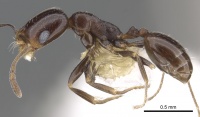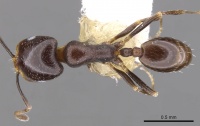Monomorium alamarum
| Monomorium alamarum | |
|---|---|

| |
| Scientific classification | |
| Kingdom: | Animalia |
| Phylum: | Arthropoda |
| Class: | Insecta |
| Order: | Hymenoptera |
| Family: | Formicidae |
| Subfamily: | Myrmicinae |
| Tribe: | Solenopsidini |
| Genus: | Monomorium |
| Species: | M. alamarum |
| Binomial name | |
| Monomorium alamarum Bolton, 1987 | |
This species has been hand collected from desert habitats.
Identification
Bolton (1987) - A member of the M. setuliferum species group. Within the group alamarum is a very conspicuous species, rendered easily recognizable by the form of its eyes coupled with the lack of standing pilosity on head, alitrunk, and first gastral tergite in front of the apical row, and the superficial reticular patterning faintly present on the head. In all other species included in the group either standing hairs are numerous (Monomorium havilandi, Monomorium xanthognathum, Monomorium macrops), or the head is very obviously densely sculptured (Monomorium ebangaense, Monomorium notulum, Monomorium setuliferum), or both (Monomorium hannonis).
Keys including this Species
Distribution
Latitudinal Distribution Pattern
Latitudinal Range: -21.22139° to -33.16667°.
| North Temperate |
North Subtropical |
Tropical | South Subtropical |
South Temperate |
- Source: AntMaps
Distribution based on Regional Taxon Lists
Afrotropical Region: Namibia (type locality).
Distribution based on AntMaps
Distribution based on AntWeb specimens
Check data from AntWeb
Countries Occupied
| Number of countries occupied by this species based on AntWiki Regional Taxon Lists. In general, fewer countries occupied indicates a narrower range, while more countries indicates a more widespread species. |

|
Estimated Abundance
| Relative abundance based on number of AntMaps records per species (this species within the purple bar). Fewer records (to the left) indicates a less abundant/encountered species while more records (to the right) indicates more abundant/encountered species. |

|
Biology
Castes
Nomenclature
The following information is derived from Barry Bolton's Online Catalogue of the Ants of the World.
- alamarum. Monomorium alamarum Bolton, 1987: 367, fig. 58 (w.) NAMIBIA.
- Type-material: holotype worker 17 paratype workers.
- Type-locality: holotype Namibia: Namib Desert, Ganab, 23°08’S, 15°37’E, 10.vi.1982, sample G 339 (A.C. Marsh); paratypes: 11 workers with same data, 6 workers Namib Desert, Tsondab Vlei, 23°55’S, 15°22’E, 4.iv.1982, sample T6 (A.C. Marsh).
- Type-depositories: BMNH (holotype); BMNH, MCZC (paratypes).
- Status as species: Bolton, 1995b: 259.
- Distribution: Namibia.
Unless otherwise noted the text for the remainder of this section is reported from the publication that includes the original description.
Description
Worker
Holotype. TL 2.1, HL 0.60, HW 0.49, CI 82, SL 0.40, SI 82, PW 0.29, AL 0.56. Eyes large, conspicuously in front of the midlength of the sides, the maximum diameter of the eye 0.33 x HW and with 8-9 ommatidia in the longest row. In profile the eye distinctly oblique, with its long axis tilted at about 350 to the long axis of the head. The anterior lobe of the eye drawn out anteroventrally down the side of the head and the eye feebly reniform. In profile the promesonotum evenly convex, the metanotal groove not impressed. Dorsal surfaces of head, alitrunk, petiole and postpetiole without standing hairs of any description, but with very sparse fine appressed pubescence present. First gastral tergite with similar appressed pubescence but without standing hairs except for an apical transverse row. Dorsum of head everywhere with vestigial very fine superficial reticular patterning. Dorsal alitrunk more strongly sculptured, finely reticulate-shagreenate on the pronotum to closely reticulate or even reticulate-punctate on the propodeum. First gastral tergite with fine superficial reticular patterning as on the head. Colour uniform dark brown.
Paratypes. TL 2.0-2.4, HL 0.56-0.68, HW 0.45-0.56, CI 79-83, SL 0.38-0.50, SI 80-90, PW 0.26-0.32, AL 0.52-0.66 (12 measured). As holotype but maximum diameter of eye 0.33-0.36 x HW and with 8-10 ommatidia in the longest row.
Type Material
Holotype worker, Namibia: Namib Desert, Ganab, 15° 37' E, 23° 08' S, sample G 339, 10.vi.1982 (A. C. Marsh) (The Natural History Museum). Paratypes. 11 workers with same data as holotype; 6 workers, Namib Desert, Tsondab Vlei, 15° 22' E, 23° 55' S, sample T 6, 4.iv.1982 (A. C. Marsh) (BMNH; Museum of Comparative Zoology).
References
- Bolton, B. 1987. A review of the Solenopsis genus-group and revision of Afrotropical Monomorium Mayr (Hymenoptera: Formicidae). Bulletin of the British Museum (Natural History). Entomology. 54: 263-452.. (page 367, fig. 58 worker described)
- Ruano, F., Tinaut, A., Soler, J.J. 2000. High surface temperatures select for individual foraging in ants. Behavioral Ecology 11, 396-404.
References based on Global Ant Biodiversity Informatics
- Bolton B. 1987. A review of the Solenopsis genus-group and revision of Afrotropical Monomorium Mayr (Hymenoptera: Formicidae). Bulletin of the British Museum (Natural History). Entomology 54: 263-452.
- Campbell H., M. D. E. Fellowes, and J. M. Cook. . Species diversity and dominance-richness relationships for ground and arboreal ant (Hymenoptera: Formicidae) assemblages in Namibian desert, saltpan, and savannah. Myrmecological News 21: 37-47.
- IZIKO South Africa Museum Collection
- Robertson H. G. 2000. Formicidae (Hymenoptera: Vespoidea). Cimbebasia Memoir 9: 371-382.

